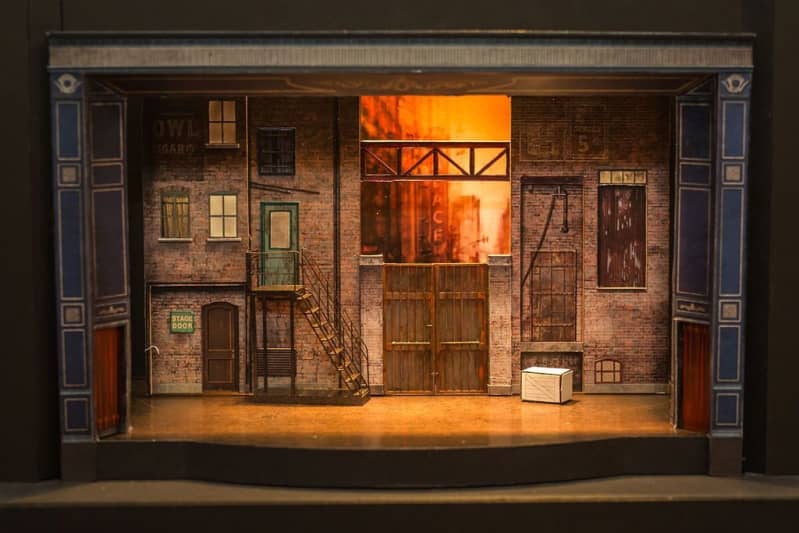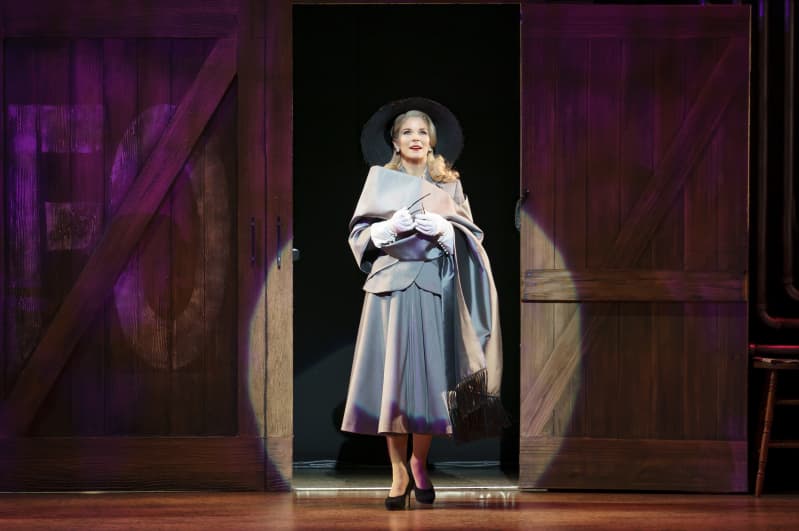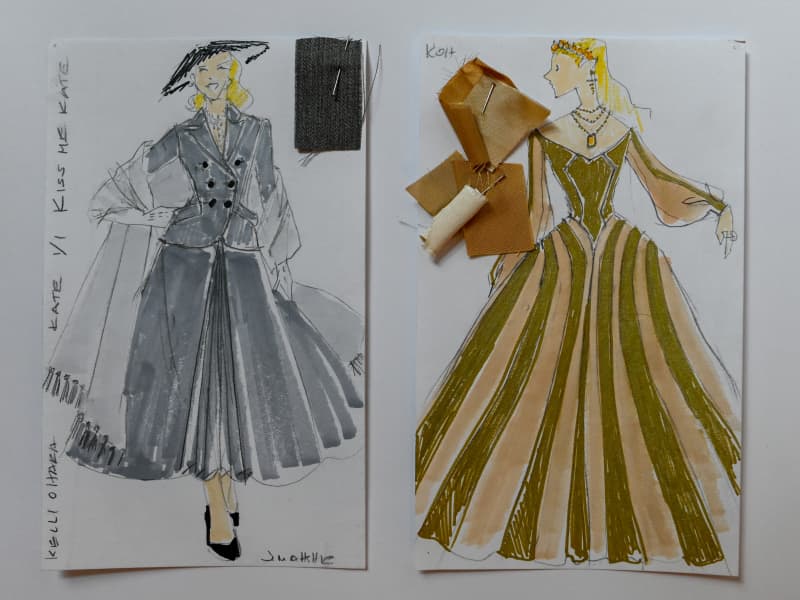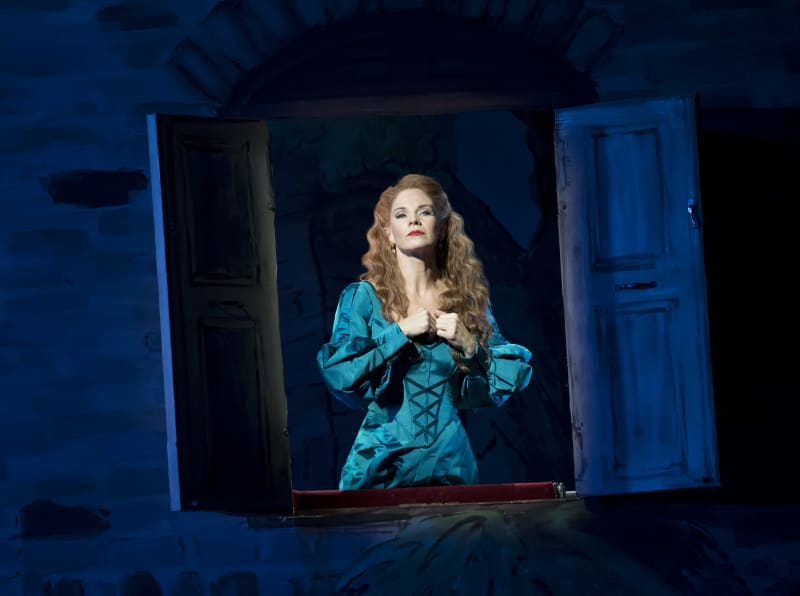Kiss Me, Kate:
Design Statements
Posted on: July 1, 2019
Nikki DiLoreto, Assistant Director
My first introduction to Kiss Me, Kate was through my 99-year-old grandmother, a fan of Cole Porter and a regular Broadway audience member during the 1940s. As a new play director, I am thrilled to be working on a giant revival of a beloved 70-year-old musical and to be assisting someone who possesses the mastery exemplified time and again by Scott Ellis. Musical revivals prompt different questions than new musicals for the directing team, namely: how does a company take on a piece from a different perspective than before and make it relevant for a modern audience? We are in a transformative moment in America for gender stereotypes; people are looking more deeply now than ever before at relationships between men and women and at the meaning of gender identity itself.
Where we are today in the United States is not where we were in post-WWII America, and it is up to this skillful team to build that link between the cultural milieu of 1948 and 2019 America. Warren and Scott have a history of amazing collaborations, getting inside the pieces, and conveying fluid storytelling throughout. As rehearsals approach, I’m excited to see how Scott, Warren, this unparalleled cast, and the rest of the creative team will penetrate the meaning of this theatrical moment.
David Rockwell, Set Design
When designing a show-within-a-show, the first challenge is to create a distinct stylistic demarcation between “reality” and “the show.” In Kiss Me, Kate, “reality” is backstage at a historic Baltimore theatre in the late 1940s, which we wanted to portray with equal parts industrial realism and showbiz romanticism. Because of the number of locations and the need for several quick changes, our representation is intentionally abstracted and fragmented, with hanging line sets and drops and flats obscured by shadow. Three attached wagons travel up and down stage and are clad in dimensional brick with applied pipes, stairs, and backstage details. Two identical dressing rooms—one for Fred and one for Lilli—are also three-dimensional and track in.
Because Studio 54 is such a nontraditional theatre space, we built a false proscenium to suggest the older-style playhouse where the action takes place. While we pulled countless research images, there was one shot in particular that Scott Ellis, the director, loved, and so much of our backstage is based on a single photograph. “The show” is a musicalized version of Shakespeare’s The Taming of the Shrew, set in Padua, which we’ve given an unmistakably theatrical, two-dimensional style, typical of stage productions of the era. Cut drops feature painted pastoral and Renaissance scenes in a naturalistic, loose, sketchy style. The hand-painted sets were manipulated digitally and reproduced to scale by scenic painters, making sure that the sketchiness of the linework was retained in the process. The ultimate goal was to create two very distinct worlds designed to complement but never compete with one another.
Donald Holder, Lighting Design
Kiss Me, Kate is a hilarious romantic comedy, filled with classic Broadway showtunes and graced with an irreverent and at times brazen sense of humor that’s derived from a unique convergence between the writings of Cole Porter, Bella and Sam Spewack, and William Shakespeare.
There’s a love for the spotlight and an over-the-top performance style both onstage and off that imbues the proceedings with a larger-than-life sensibility. The musical seamlessly navigates between the gritty yet glamorous backstage environs of a Baltimore theatre and the whimsical Elizabethan settings of “the show.” The lighting will underscore the unique qualities of these two worlds. The behind-the-scenes environs will feature a golden and sepia-toned palette, referential to the incandescent lighting sources that were common during the time period of the play.
The sense of light streaming through theatrical rigging and theatre infrastructure, casting interesting and unexpected patterns of light and shadow, will also be a dominant part of the backstage lighting vocabulary. The light for the play within the play will feature a richly hued and layered color palette, rendered much like a three-dimensional version of the painterly scenic backgrounds that David Rockwell has created for the production. Kiss Me, Kate is energetic and jubilant, revered for its ability to entertain and delight. The lighting will deliver this energy to the production on a visceral level, revealing sparkling and vivid stage pictures that allow the audience to lose themselves in a show that seems from another time, but feels just as vital and intoxicating as it did the day it premiered.
Jeff Mahshie, Costume Design
This show takes place in the late 1940s, as well as the 16th century. Scott likes to approach revivals with a new take, so when we began the conversation about the costumes, we discussed how the show had been handled in the past. Most productions have used a traditional musical comedy approach when designing the clothes.
During this time period, America was becoming highly sophisticated and cultured. Cole Porter’s music and lyrics have urbane wit and, given the fashions of the time, we feel our production should lend itself to a chic interpretation without sacrificing comedy. This era was truly a revolutionary time in fashion. The postwar “New Look” by Christian Dior swept the fashion world. Kelli O’Hara’s character, Lilli, even references her “New Look” wardrobe in the script. The fashion designs of this era are quite luxurious, in direct response to years of wartime fabric rationing.
This new extravagance sets the tone for my designs. Many leading ladies during this time period went to their favorite fashion designers to create their stage costumes, so even the 16th-century garments will be created through the lens of the late 1940s. I’ve worked very closely with David Rockwell, the set designer, so our color choices harmonize. I have consulted with Warren Carlyle, the choreographer, so the clothes move with the actors and enhance his work on the dancing. It’s been a lot of hard work, but with Scott Ellis at the helm, we are always guaranteed to have tremendous fun.
David Brian Brown, Hair and Wig Design
My research for the hair and wig design is based on two distinctly different time periods: the late 1940s and the 16th century. I consulted numerous historically authentic paintings, films, photographs, books, yearbooks, fashion magazines, retail catalogs, and press/newspapers of those respective periods. My collaboration is mainly with the costume designer, whose work will dictate who these characters are. I also take into consideration the director’s take on individual characters, the actor’s take on her/his character, and Warren Carlyle’s choreography, which is very energetic.
When a wig dances, you want it to swing back into place when the movement stops! After receiving and processing all the above information, I choose colors and styles for each character, which I then share with the costume designer. Hair colors need to compliment the colors of the costumes. The wigs are then made, which takes about eight weeks, and there are approximately 24 wigs being made for this show. All the wigs are custom made, with lace fronts, and are completely hand tied. Once the wigs have been made, they are cut and styled, followed by a final fitting with the actor.
Brian Ronan, Sound Design
My first exposure to Kiss Me, Kate was the wonderful revival in 1999. I was still mixing sound as an operator back then and was beginning to dabble in my own sound designs. At the time, I was mixing Rent on Broadway and had that driving rock score flowing through my veins. From the moment the Kiss Me, Kate overture began, my ears re-opened to a traditional Broadway score. With Brian Stokes Mitchell and Marin Mazzie singing the leads, the music reminded me that this classic sound had a firm place in what I thought to be contemporary music’s landscape.
My old friend, sound designer Tony Meola, had done his usual magic, and the show had a pure sonic quality that I knew one day I’d emulate. That this current revival is playing at Studio 54 allows me as a designer to harness the room's classic architecture to compliment the pure orchestrations played by these musicians and sung by this insanely talented cast.
Kiss Me, Kate is now running through June 30 at Studio 54.
Photos by Joan Marcus.




